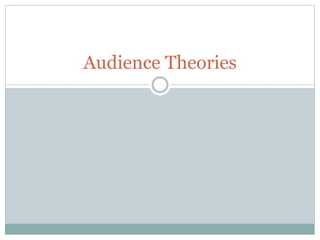
Audience Theories
- 2. Cultivation Theory This theory was developed by George Gerbner and was derived from a project called ‘Cultural Indicators’ in which they set out to identify and track the cultivated effects of television on viewers. It is a social theory which examines the long term effects of television. It suggests that watching television changes people’s attitudes and not their behaviors. The combined effect of large amounts of television exposure by viewers over time subtly effects their perception of social reality – individuals and our society as a whole. This theory is known as a stalagmite theory as it suggests that the effect of media is over a long period of time – like a slow buildup of formations on a cave floor.
- 3. Cultivation Theory The theory discovered that there were two main types of viewers who had different outlooks on the social reality of life. The first are ‘Heavy Viewers’ who watch over 4 hours of a television per day. The second are ‘Light Viewers’ who watch less than 2 hours of television per day. After research in to the theory they discovered that heavy viewers had a more cynical outlook on society and believed they were likely to be attacked if out at night. Whereas, light viewers had a more trustworthy view on society and were not scared of being attacked when out at night.
- 4. Dyer’s Utopian Theory Richard Dyer believes that audiences consume media products with a clear set of pleasures to draw from that experience. His Utopian theory is linked with the Uses and Gratifications Theory. Both theories suggest that audiences consume media products because they wish to escape reality. It implies that reality is full of negatives and stress, whilst the world of media represents an escape from this stress. “Entertainment offers the image of ‘something better’ to set against the realities of day-to-day existence.”
- 5. Dyer’s Utopian Theory Dyer had three reasons why audiences chose to consume media: 1. Social Tension – the fear of being constantly criticized and so they try to avoid social situations. 2. Inadequacy – feeling as if they are not good enough. 3. Absence – feeling as if something is missing in their life. He believes that these are generated by reality and the consumption of media provides audiences with a ‘utopian solution.’
- 6. Social Tension Utopian Solution Exhaustion Work as grind Alienated labour Pressures of urban life Energy Acting Vigorously Human power and activity Scarcity Actual poverty Unequal distribution of wealth Abundance The conquest of scarcity Having enough and to spare Enjoyment of sensuous, material things Dreariness Monotony Predictability Daily Routine Intensity Experiencing of emotion Directly, fully, authentically Without holding back Manipulation Advertising Bourgeois democracy Sex roles Transparency Open, spontaneous, honest communications and relationships Love, sincerity Fragmentation Job mobility Rehousing, development High-rise urban life Community Togetherness Communal Interests Sense of belonging
- 7. Reception Theory The reception theory is split into three different models: Dominant Reading (hegemonic) This is when the consumer takes the actual meaning directly and decodes it exactly the way it was intended. It is the way the the producer intends us to receive it. Negotiated Reading This is when the consumer accepts the meaning but does not necessarily agree with it and so they modify it to a meaning they prefer. Oppositional Reading (non-hegemonic) This is when the consumer completely disregards the intended reading and misinterprets it so that they take it the wrong way. This is usually when a reader takes something positive and sees it in a negative way.
- 8. Uses And Gratifications Theory (UGT) UGT is an approach to understanding why people actively seek out specific media to satisfy specific needs. The driving question of UGT is: why do people use media and what do they use them for? UGT discusses why people choose to media that will satisfy given needs and allow one to enhance knowledge, relaxation, social interactions/companionship, diversion or escape.
- 9. Uses And Gratifications Theory (UGT) Information Finding out relevant events and conditions in immediate surroundings, society and the world. Seeking advice on practical matters or opinion and decision choices. Satisfying curiosity and general interests. Learning; self education. Gaining a sense of security through knowledge. Personal Identity Finding reinforcement for personal values. Finding models of behaviour. Identifying with valued others in the media. Gaining insight into one’s self
- 10. Uses And Gratifications Theory (UGT) Integration and Social Interaction Gaining insight into circumstances of others; social empathy. Identifying with others and gaining a sense of belonging. Finding a basis for conversation and social interactions. Having a substitute for real-life companionship. Helping to carry out social roles Enabling one to connect with family, friends and society. Entertainment Escaping, or being diverted, from problems. Relaxing Getting intrinsic cultural or aesthetic enjoyment Emotional release Sexual arousal
- 11. Maslow’s Hierarchy of Needs Maslow’s Hierarchy of Needs suggests that people use media to fulfill their own personal needs. The hierarchy of needs is often portrayed as a pyramid with basic human needs at the bottom and self-actualisation at the top.